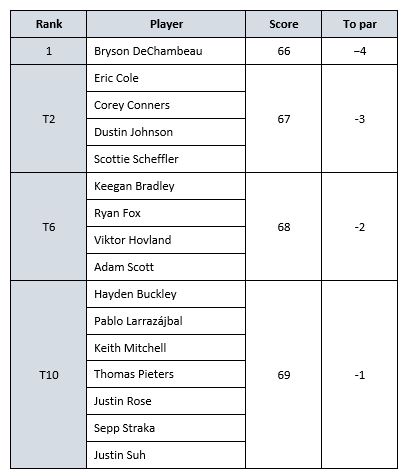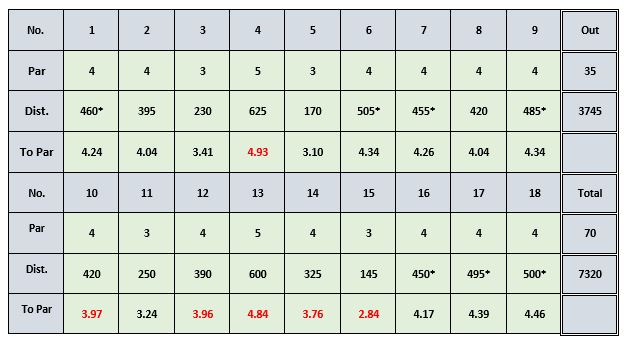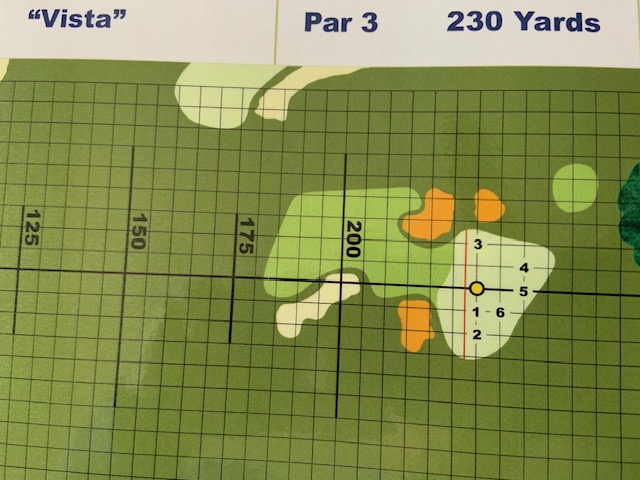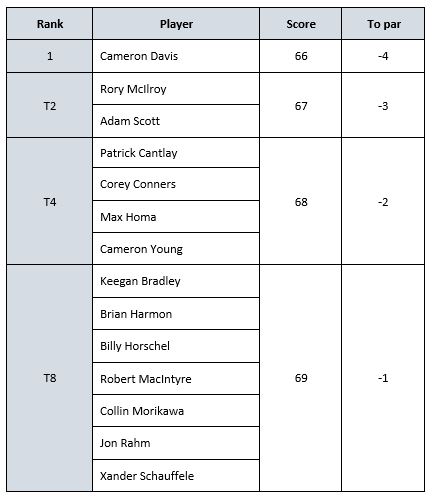This post describes the results of the first round of my 2023 PGA Championship Replay at Oak Hill (Acorn Hill). Previous posts have addressed some of the specific challenges of playing this course, setting up the day conditions, history of the event, and the tournament outcome in 2023. As always, I will summarize what happened in the actual event followed by the replay results.
Actual Event
In round 1, the starting 156-player field’s average score was 73.7 strokes. Of the 76 players that would play all four rounds of the tournament (i.e., the qualifiers), the average 1st round score was 71.6 strokes. With par set at 70, the overall field and qualifiers were 3.7 and 1.6 strokes over par, respectively.
The lowest score of the day was a 66 posted by Bryson DeChambeau, a member of the LIV tour and not carded by APBA for the 2023 season. The highest score turned in for the day and the tournament overall was 84 by Chris Sanger (also not carded), a club pro from a 9-hole course in upstate New York. He was one of 20 PGA club pros that were eligible for the tournament.
The top of the leaderboard for the first round of the actual tournament is provided below.

The eventual winner, Brooks Koepka, started the tournament with a 2-over par round of 72 and thus did not make the top 10 leaderboard. Eventual runner-ups, Scheffler (67) and Hovland (68), finished round 1 near the top of the leaderboard with Scheffler (T2) and Hovland (T6).
The Replay Event
For round 1 the pin was located at position 2, the wind was Calm (Prevailing Type-C) and course conditions were Normal (i.e., no fairway or green roll adjustments).
As described in an earlier post, Acorn Hill’s fairways are narrow (averaging about 22 yards wide at 275 yards off the tee). They are also generously tree-lined, guarded by strategically placed fairway bunkers, and have water either crossing or lining the fairways on six holes. Moreover, a unique course board rule stipulates that no more than a 7-iron may be used from the rough, with the added provision that for lie rolls of 11 – 46 the result is read six lines below the actual dice roll.
The net effect of this rule is that shots from the rough are not only made more unpredictable than usual, but also these shots may not reach the green on the longer par 4’s. I will further explore the effects of this rule shortly.
The hole layout and average scores for round 1 are provided below. Note the seven par 4’s of 450 yards or more (as indicated by an * on the yardage in the table).

The Challenge of Reaching Greens in Regulation (GIRs)
Let’s assume the player’s drive finished at 290 yards from off the tee and 30 yards left of the Centerline (CL) in the rough. By APBA math, a carry penalty of 10 yards (5 for every 15 yards off the CL) is applied to the next W/I shot. Restricted to the use of no more than a 7-iron out of the rough, a player’s shot with a PRN of 5 (a good outcome for the average player) will carry 155 yards and roll 5 yards (160 yards in total). In this situation, the best that a PRN of 5 supports (using a 7-iron) is a shot to a target at 290 – 10 + 160 = 440 yards, as measured from tee.
Complicating matters, the majority of bad drives are way less than 290 yards and many of them are more than 30 yards off the CL. At Acorn Hill, bad drives also frequently get blocked by trees, which requires an additional carry penalty for hitting around the trees. Therefore, logic says the 7-iron rule, combined with these other factors, pretty much assures that shots on these seven long par 4’s will seldom reach the flag and most likely will not even make the front edge of the green.
The data from round 1 are consistent with that theory. As shown in the table above, the replay field of 70-carded players that participated in the event was 2.22 strokes on average over par on these seven holes alone, and yet just 2.26 strokes over par on average for all 18 holes. While the two long par 3’s (hole nos. 3 & 11) challenged the replay field, the players were able to make up strokes on the two par 5’s, the one shorter par 3, and the shorter par 4’s.
With regard to missing greens, special mention goes to hole no. 3, a 230-yard par 3 that it is guarded by a deep bunker across the front of the green’s right side. The only way to roll onto the green is left of the CL. The course board has a red line drawn across the front of the green, stipulating that any ball landing short of the line must roll back 10 yards then stop (ignoring any lie roll), and a ball coming to rest short of the line must roll back 5 yards. In both cases, the shot rolls off the green.
The green for hole no. 3 is shown below.

From the table above, we see that hole no. 3 was the second hardest hole in round 1 (0.41 strokes over par). Few APBA-carded players can hit a tee shot that goes at least 230 yards without rolling more than 10 yards, assuming you are accurate enough to land the ball on the green.
With the red line rule in effect, this small green offers little chance of driving the ball to a spot on the green that won’t roll off–either to the front or back. A 4-wood, 5-wood, or a hybrid might work with a longer hitter; otherwise, you are better off using a 2-iron and trying to “thread the needle” through the deep bunkers in front of the green.
Note that the round 1 pin location (no. 2) is on the right side of the green. This made for some very long putts for the few tee shots that found the green on the left side. More often, tee shots resulted in approaches from the rough or one of the deep bunkers surrounding the green.
As a result of these challenges, Greens in Regulation (GIRs) were 54% for the replay contestants in round 1. Across the full tournament, the actual qualifiers averaged 60.5%. Neither sets of data make for a glowing report card and go a long way to explain why both groups of players were over par for their respective tournaments.
Replay Leaderboard
For the replay’s round 1 Cameron Davis posted the day’s best score with a 66, finishing 4-under par. The worst score for the round was an 82 posted by Nico Echavarria, who had won the 2023’s Puerta Rican Open. Rory McIlroy and Adam Scott tied for second place (67). By carding scores of 68, Patrick Cantlay, Corey Conners, Max Homa, and Cameron Young tied for fourth place.
Regarding the eventual top three finishers from the actual tournament, Brooks Koepka (the actual winner) shot a 73 in the round 1 replay; runners-up Scottie Scheffler and Viktor Hovland both shot par (70). At this point in the replay, it seems all three players are very much in contention.
The top of the leaderboard for round 1 of the replay is provided below.

Highlights for round 1 include:
- J.T. Poston drove hole no. 14’s green (a 320-yard par 4).
- Eagles: J.T. Poston and Brian Harman (hole no. 14); Rory McIlroy (hole no. 16).
- Harris English hit 12 of 14 fairways. (Avg. = 7.3)
- Rory McIlroy hit 15 greens in regulation. (Avg. = 9.7)
- Emiliano Grillo led all players in average driving distance (two holes) at 320 yards. (Avg. = 286)
- Rory McIlroy led all players in average driving distance (all drives) at 309 yards. (Avg. = 280)
- Ben Griffin, Beau Hossler, and Rory McIlroy had the longest drives (365 yards).
- Corey Conners sunk the longest putt at 61 feet on hole no. 12.
- Russell Henley had the longest total distance of putts made. (126 feet).
- Cameron Young had the fewest putts with 24. (Avg. = 29.0)
- Lee Hodges, Justin Rose, and Sahith Theegala tied for most putts at 33.
- Nico Echavarria was 0 for 7 out of green side bunkers (taking 4 strokes to get out of a deep bunker on hole no. 15).
Very thorough explanation of Acorn Hill and the first round. I haven’t played that course yet, sounds tough.